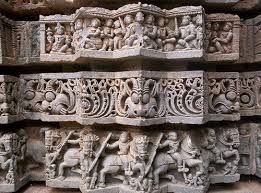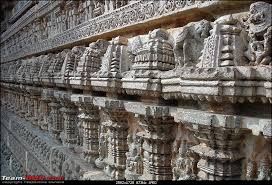

Frontal view, Kesava temple, Somanathapura
The temple is housed inside an impressive high wall and the entrance to the complex is through a porch with tall lath
e-turned
pillars.The material used for the temple is chloritic schist or
soapstone. The main reasons that make the Keshava temple standout amidst
the large number of Hoysala monuments are its symmetrical architecture,
fine sculptures on equally prominent shrines, and a temple that is surrounded by panels forming a cloister. While there are Hoysala temples
with better sculpture and others with better architecture, this temples
satisfies all requirements. It was built by the famous
architect/sculptor Ruvari Malithamma who was well known for his
expertise in ornamentation.




The temple which is built on a jagati (platform)is a trikuta (triple
shrined) and fully satisfies the terminology as all vimanas (shrines)
have a superstructure (tower).Inside the temple, each vimana has a
vestibule that connects it to the main rectangular mantapa (hall). Like
the shrines, all three vestibules also have their own tower which is
called the sukanasi (or nose), though it is shorter and hence looks like
a low extension of the main superstructure over the shrine. The outer
walls of all three shrines, their towers and nose are equally well
decorated, making it overall a very well balanced design. The temple
stands on a jagati (platform) and the three vimanas are located at the
back and are connected by a common rectangular closed mantapa.

The
jagati closely follows the plan of the temple and there is a gallery
with lathe-turned pillars all along the sides of the temple complex
which adds to the effect. There is one flight of steps that leads to the
jagati and one that leads from the jagati into the mantapa. The wide
jagati invites devotees to follow the ritualistic clockwise
circumambulation before entering the temple hall. The full effect of the
rectangular hall is seen only when the temple profile is viewed. The
hall has 16 bays. The outside wall of the hall is well decorated with
relief friezes, and pierced windows screens above them.
All the
three shrines have a 16 pointed stellate (star-shaped) design and their
towers follow the same pattern. Hence the whole structure looks like a
rhythmic progression of well decorated projections and recesses. The
number of points make the towers look circular.
Gallery[edit]
- Chennakesava Temple Gallery
View of the
trikuta (three towers over three shrines) above the
prakara (bounding wall) at the Chennakesava temple, Somanathapura
Wall relief, pierced windows and molding frieze at the Chennakesava temple, Somanathapura
Profile of Chennakesava temple, Somanathapura
Relief carvings on tiered (tala) superstructure over the shrine (vimana) at Chennakesava temple, Somanathapura
Close up of decorative lintel over shrine entrance in the Chennakesava temple at Somanathapura
Deity sculpture on shrine outer wall in the Chennakesava temple at Somanathapura
Deity sculpture under eves on shrine outer wall in the Chennakesava temple at Somanathapura
Deity sculpture under eves on shrine outer wall in the Chennakesava temple at Somanathapura
Shrine wall relief sculpture follows a stellate plan in the Chennakesava temple at Somanathapura
Old Kannada inscription (1270 AD) in the Chennakesava temple at Somanathapura
Decorative wall molding frieze and deity sculpture in the Chennakesava temple at Somanathapura
Design of sikhara (tower) follows the stellate plan of the shrine in the Chennakesava temple at Somanathapura
Minor shrine (aedicula) with domical ceiling in the Chennakesava temple at Somanathapura
- Minor shrine (aedicula) inside the Chennakesava temple at Somanathapura
Stellate plan of the shrine and sikhara (tower) in the Chennakesava temple at Somanathapura
Domical bay ceiling in the mantapa of Chennakesava temple at Somanathapura
Domical bay ceiling in the mantapa of Chennakesava temple at Somanathapura
Domical bay ceiling in the mantapa of Chennakesava temple at Somanathapura
Domical bay ceiling in the mantapa of Chennakesava temple at Somanathapura
Domical bay ceiling in the mantapa of Chennakesava temple at Somanathapura
Domical bay ceiling in the mantapa of Chennakesava temple at Somanathapura
Domical bay ceiling in the mantapa of Chennakesava temple at Somanathapura
Domical bay ceiling in the mantapa of Chennakesava temple at Somanathapura
Decorative doorjamb and lintel at the entrance to a shrine in the Chennakesava temple at Somanathapura
http://en.wikipedia.org/wiki/Chennakesava_Temple,_Somanathapura

























No comments:
Post a Comment